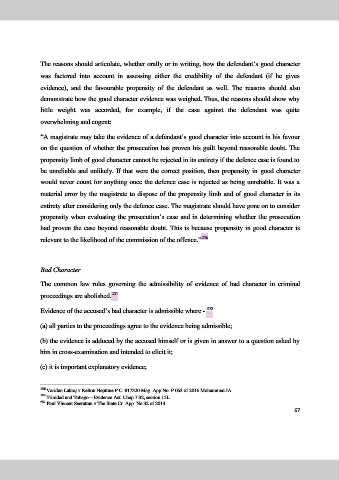Page 406 - Magistrates Conference 2019
P. 406
The reasons should articulate, whether orally or in writing, how the defendant’s good character
was factored into account in assessing either the credibility of the defendant (if he gives
evidence), and the favourable propensity of the defendant as well. The reasons should also
demonstrate how the good character evidence was weighed. Thus, the reasons should show why
little weight was accorded, for example, if the case against the defendant was quite
overwhelming and cogent:
“A magistrate may take the evidence of a defendant’s good character into account in his favour
on the question of whether the prosecution has proven his guilt beyond reasonable doubt. The
propensity limb of good character cannot be rejected in its entirety if the defence case is found to
be unreliable and unlikely. If that were the correct position, then propensity in good character
would never count for anything once the defence case is rejected as being unreliable. It was a
material error by the magistrate to dispose of the propensity limb and of good character in its
entirety after considering only the defence case. The magistrate should have gone on to consider
propensity when evaluating the prosecution’s case and in determining whether the prosecution
had proven the case beyond reasonable doubt. This is because propensity in good character is
relevant to the likelihood of the commission of the offence.” 250
Bad Character
The common law rules governing the admissibility of evidence of bad character in criminal
proceedings are abolished. 251
Evidence of the accused’s bad character is admissible where - 252
(a) all parties to the proceedings agree to the evidence being admissible;
(b) the evidence is adduced by the accused himself or is given in answer to a question asked by
him in cross-examination and intended to elicit it;
(c) it is important explanatory evidence;
250 Varidan Lakraj v Kelton Neptune P.C. #17320 Mag. App No. P 063 of 2016 Mohammed JA
251 Trinidad and Tobago – Evidence Act. Chap 7.02, section 15L
252 Paul Vincent Seerattan v The State Cr. App. No 32 of 2013
67

